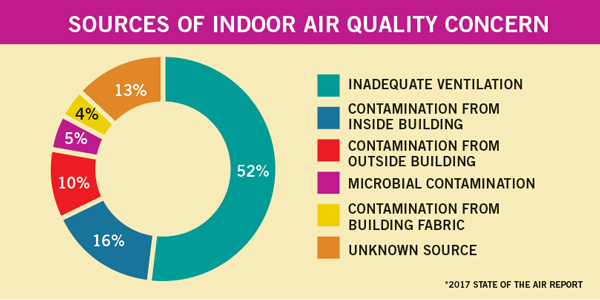Understanding the importance of clean air and biophilia—incorporating nature and natural elements into different environments, and how they can enhance concentration and productivity, can be a key factor in the success of your meetings.
In my previous position as senior vice president at MGM Resorts International and as a proponent of its Stay Well Meetings design initiative, I was immersed in studying the impact of behavioral science and the role it plays in creating environments that are most conducive to mental acuity, collaboration and creativity.
Breathing is an unconscious activity for us all, and as such we tend to take for granted the importance of the quality of air we’re inhaling.
[Related Content: How Lighting Affects Mood and Meetings Performance]
The average person breathes in more than 33 pounds of indoor air daily, and as we age, our body’s ability to compensate for the effects of air pollution become more limited.
Most conventional buildings do not offer enough ventilation, which has been shown to limit some areas of cognitive function. Concentration of pollutants can be two to five times higher indoors compared to outdoor locations.
Added to instances of poor ventilation are the pollutants created by surface materials such as furniture and technical appliances—everyday surroundings that we take for granted.
How Filtered Air Creates a More Healthy and Productive Meeting
An important part of the Stay Well Meetings design is the Rabbit Air purification unit, which filters the air in a room up to four times per hour.
This allows for the reduction of pollen, allergens, toxins, pathogens and odors.
A review of 15 studies has found that improved ventilation—and thus better air quality—was linked with gains in individual productivity of up to 11 percent.

We cannot evaluate air without an understanding and introduction of biophilia and other natural elements into meeting environments.
Humans have an inherent inclination toward nature, which makes it critical to incorporate natural elements in meeting room design. In addition to offering a calming effect, which has proven to increase concentration levels, it impacts mood and comfort levels.
From a science perspective, living walls and other biophilia elements help purify the air in a variety of ways. Harmful chemicals are absorbed through the plants and soilless growing mediums, which helps purify the air. In the living walls found in Stay Well Meeting spaces, small fans in each plant unit return the naturalized filtered air back into the room.
[Related Content: Sensory Inclusive Event Venues – Why They Matter]
Biophilia also creates humidity, which helps reduce eye irritation and the allergy-like symptoms that so many of our meeting attendees suffer from daily. These allergies and symptoms can sometimes be compounded when traveling for business.
To truly create the most effective spaces for our meetings community, behavioral science must be at the forefront of the design and thought process. The research, science and partners exist today for our industry to innovate in a way that is affordable and thoughtful in design.
When we meet, we change the world. With thoughtfulness in design, we create better meetings environments and help inspire that change through enhanced productivity.
[Read This Next: Using Science to Create a Better Meetings Experience]







